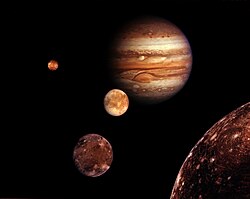 | |
| Discovery | |
|---|---|
| Discovered by | Stephen P. Synnott / Voyager 2 |
| Discovery date | January 3, 1986 |
| Designations | |
Designation | Uranus XI |
| Pronunciation | /ˈdʒuːliɛt/ [1] |
| Adjectives | Julietian [2] [3] |
| Orbital characteristics [4] | |
| 64,358.222 ± 0.048 km | |
| Eccentricity | 0.00066 ± 0.000087 |
| 0.493065490 ± 0.000000012 d | |
| Inclination | 0.06546 ± 0.040° (to Uranus's equator) |
| Satellite of | Uranus |
| Physical characteristics | |
| Dimensions | 150 × 74 × 74 km [5] [note 1] |
| ~30,000 km2 [a] | |
| Volume | 430100 km3 ± 23.0% [6] |
| Mass | (3.871±0.891)×1017 kg [6] |
Mean density | 0.5–1.2 g/cm3 [7] 0.9 g/cm3 (assumed) [6] |
| synchronous [5] | |
| zero [5] | |
| Albedo | 0.08 ± 0.01 [8] |
| |
Juliet is an inner satellite of Uranus. It was discovered from the images taken by Voyager 2 on 3 January 1986, and was given the temporary designation S/1986 U 2. [9] It is named after the heroine of William Shakespeare's play Romeo and Juliet . It is also designated Uranus XI. [10]
Contents
Juliet belongs to the Portia group of satellites, which also includes Bianca, Cressida, Desdemona, Portia, Rosalind, Cupid, Belinda, and Perdita. [8] These satellites have similar orbits and photometric properties. [8] Other than its orbit, [4] size of 150 km × 74 km (93 mi × 46 mi), [5] and geometric albedo of 0.08, [8] little is known about Juliet.
In Voyager 2 imagery, Juliet appears as an elongated object, with its major axis pointing towards Uranus. The ratio of axes of Juliet's prolate spheroid is 0.5 ± 0.3, which is a rather extreme value. [5] Its surface is grey in color. [5]
Juliet may collide with Desdemona within the next 100 million years. [11]

